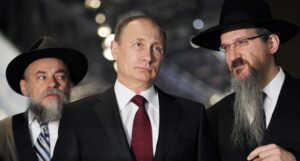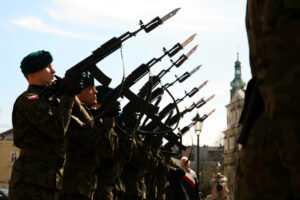For the second time in as many years, the Kremlin is deliberately fomenting a refugee crisis. In late 2021, it helped embolden the threats of Belarusian President Alexander Lukashenko to “flood” Europe with migrants, targeting Poland and the Baltic countries. Now, over the past few weeks, Russian authorities have been forcibly pushing hundreds of migrants and refugees towards Finland’s eastern frontier.
Yesterday, as a result, the Finnish government sealed its entire border with Russia, with Estonia threatening to do the same. Meanwhile, the European Union’s border agency Frontex has pledged to deploy personnel to Finland’s border.
Predictably, Russia has denied any foul play, but few are convinced. Moscow’s actions are doubtless linked to Finland’s recent entry into Nato and its new defence pact with the United States, negotiated earlier this month. In response, a number of media outlets have interpreted this latest episode in Russia’s hybrid war as an act of revenge: threaten Russia’s security periphery, and face chaos on your own frontiers.
But, though deeply tied to its security calculus, Russia’s motivations go much deeper than that. Nearly two years into his war in Ukraine, these actions play a key role in supporting Putin’s fear-based domestic propaganda narratives. By pitting the encroaching threat of Nato against the livelihood of Russia’s public, he can justify the gradual reorientation of its society and economy towards a semi-permanent war-footing. At the strategic level, the move is also part of a broader vision of Russia’s geopolitical future, and its conception of competing hegemonies in northern and eastern Europe.
Before last year, Finland had been dependably neutral towards Russia for decades. But Russia’s invasion of Ukraine triggered a national reckoning in the country, and support for Nato membership among Finns jumped to nearly 80% in late 2022. Despite never being part of the Soviet Union, Finland is no stranger to Russian aggression. It was under Russian occupation for over a century until 1917, and famously repelled a Soviet invasion during the Second World War.
Finland’s reorientation has thus predictably been utilised by the Kremlin as an opportunity to play the victim, presenting the current situation on the Finnish-Russian border as an attack on Russians, rather than a crisis of its own making. “They have to keep up the appearances, to make up these kinds of narratives, for themselves, for the population in Russia,” Pentti Forsström, a senior researcher at Finland’s National Defence University, and a retired lieutenant colonel in the Finnish Defence Forces, told me. “Now they are using every bit and piece of what we are doing, [like] closing the border, [to argue] that we are the ones to blame.”
In response to the border closures, the governor of Russia’s Murmansk region that borders Finland has already introduced “a heightened state of readiness… to ensure the security of our residents”, while Russians living in Finland have staged protests accusing the Finnish government of disrupting cross-border family ties.
This type of rhetoric aligns perfectly with Putin’s claims regarding a Russophobic West that infringes upon “the Russian world” and threatens communities in its near-abroad. Though the West used to take them less seriously, such claims have now become part of a longstanding narrative to validate Russian expansionism: protecting ethnic Russians was a large part of Moscow’s official justification for its invasion of Ukraine in 2022, as well as that of Georgia in 2008.
Not only that, but a crisis like the one along Finland’s border provides fresh “evidence” for the Kremlin to keep everyday Russians convinced of Nato’s aggressive presence. And this propaganda fodder is more necessary now than ever. Russia is quietly transitioning its economy and defence industry to a long-term war posture, and is facing a resurgence of political pushback from its people as it tries to recruit more troops for its fight in Ukraine. It is crucial that ordinary Russians continue to see the conflict as an existential threat to their way of life, for which it is worth sacrificing livelihoods — and lives.
Finland’s growing military co-operation with the US, and recent promises of support from Poland — a regular focus of Kremlin propaganda — make Finland a perfect place to roll out this strategy. For this reason, talking heads in the Russian media are already hinting that this is only the beginning of Russia’s hybrid war against Finland. In one notable clip, TV host Tigran Keosayan (who is married to the infamous head of Kremlin propaganda outlet RT, Margarita Simonyan) laid out the logic of this rhetorical campaign. “Dear Finns,” he said recently on his programme, “first you banned us from entering by car, now by bicycle” — a reference to the bicycles Russian authorities had allegedly given to migrants on their way to the Finnish border. “You leave us with no choice,” he finished, as a cartoon of a tank appeared onscreen.
However, there is a further element to Russia’s strategy that often gets lost in our feverish news cycle. Finland’s position in the north-eastern Baltic Sea and its proximity to Russia’s strategically important Kola Peninsula have made it critical for Russia’s naval ambitions for more than a century.
For Russia, access to warm-water ports is a permanent objective, essential for projecting global power. A neutral Finland had meant that St Petersburg — which Peter the Great originally built as the country’s navigational and cultural gateway to the West — could provide Russia with a secure maritime corridor for a naval presence in the Baltic. But since the shifting of alliances over Ukraine, this has changed. With Finland now joining Estonia within Nato’s embrace, the military alliance could conceivably blockade the entirety of the Gulf of Finland, reducing Russia’s sea access to its militarily significant (but territorially microscopic) Kaliningrad exclave.
For years now, Russia has been laying the groundwork to capitalise on warming temperatures in the Arctic Sea, which, in addition to opening up new trade networks and oil and gas reserves, present an opportunity to literally circumnavigate this hypothetical Nato blockade via its northern coastline. And this goal is intimately connected to the security of the ice-free Arctic port of Murmansk on the Kola Peninsula, which hosts a significant Russian nuclear-deterrence force just a stone’s throw north-east of Finland.
By this ominous logic, however, Russia’s geopolitical interests in the region are driven by the same strategic impetus as Russia’s seizure of Crimea in 2014 and its push to cut Ukraine off from the Black Sea in 2022: a desire to control crucial waterways that allow Russia to escape the prison of the Eurasian landmass. Presumably with such considerations in mind, the Russian military confirmed earlier this year that it would be splitting its Western Military District in two and creating a new locus of military activity right along Finland’s borders, reviving the Leningrad Military District that had been dormant since 2010.
Well before this month’s escalation, it was proof that the escalating hybrid war playing out on Finland’s border is only the beginning of a broader Russian campaign against the country. For Putin, this is the culmination of his twin desires: to bolster his jingoistic narrative at home; and to reinvest in a neglected theatre of great-power competition. For Finland, though, this all means only one thing — the period of quiet rapport it enjoyed between Nato and Russia has come to a definitive end, replaced by an anxious new world of menace and instability.
Disclaimer
Some of the posts we share are controversial and we do not necessarily agree with them in the whole extend. Sometimes we agree with the content or part of it but we do not agree with the narration or language. Nevertheless we find them somehow interesting, valuable and/or informative or we share them, because we strongly believe in freedom of speech, free press and journalism. We strongly encourage you to have a critical approach to all the content, do your own research and analysis to build your own opinion.
We would be glad to have your feedback.
Source: UnHerd Read the original article here: https://unherd.com/




